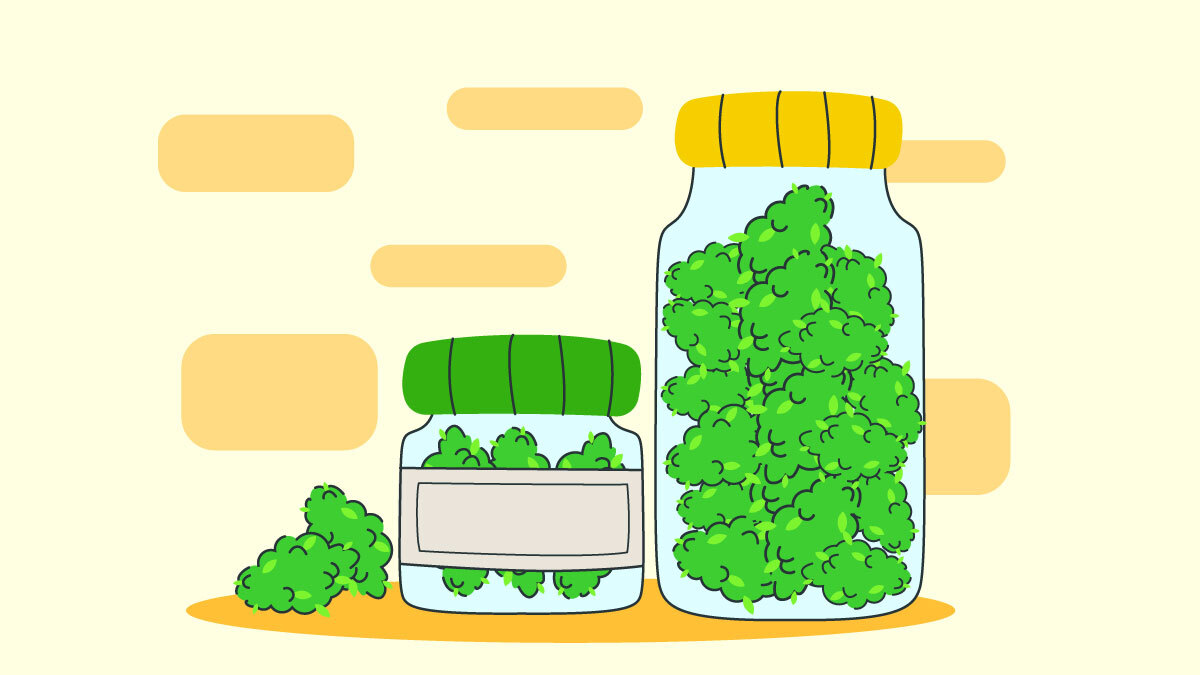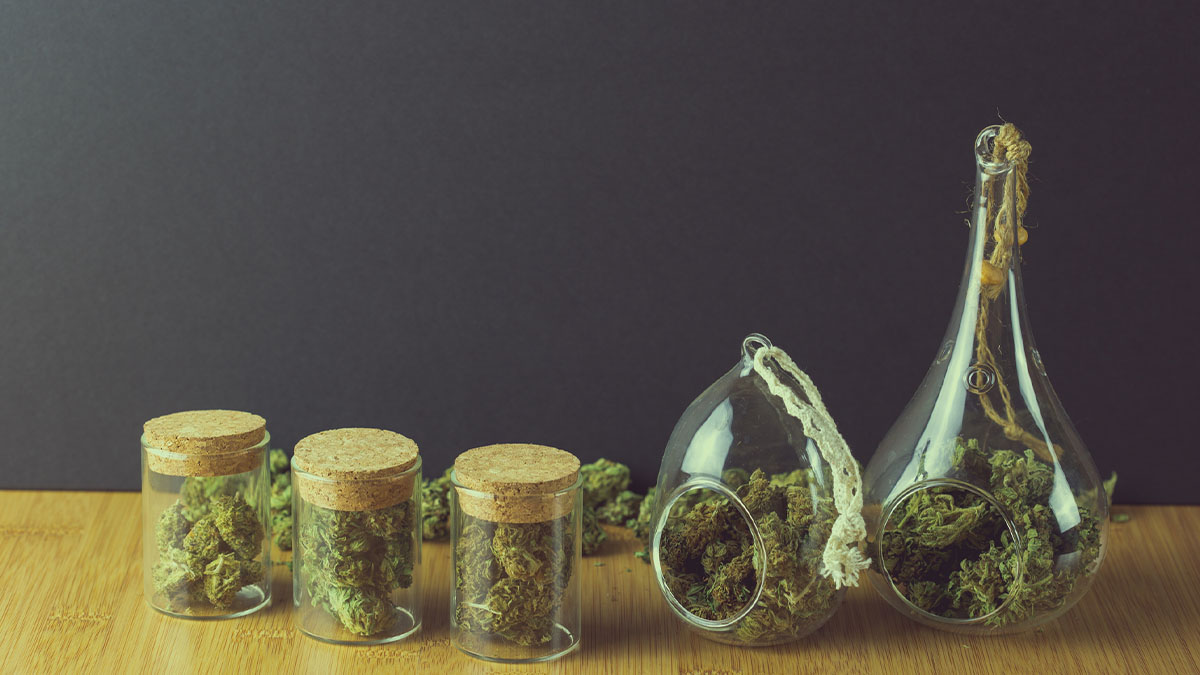How to Store Weed

Your parents used baggies. Your grandparents may even have used baggies. Perhaps your older siblings still use baggies, or your friends use them.
You should be smarter than that.
Weed has traditionally been stored in baggies. Quite honestly, that’s a terrible idea.
Storing your stash in any container that can be penetrated by light and/or air is an invitation for those elements to degrade and eventually destroy the bud. So is a container that allows moisture to build up inside.
You pay a lot for weed. Or, if you grow your own, you spend a lot of time, money, and effort planting, caring for, and harvesting your crop.
It makes sense to protect it the best way you can. Here’s how to do it.
Why Proper Weed Storage Matters
Firing up a bowl of old weed can be a very disappointing experience. The flower will often have lost much of its flavor, aroma, and, worst of all, potency.
Why does that happen? It’s usually because three of weed’s natural enemies have been able to get into the stash.
Moisture
Moisture is usually the number one culprit, and that’s a big reason why we’ve been so critical of storing herb in plastic bags.
Let’s start with the fact that even after cannabis has been dried and cured, it still has somewhere around 10-15% water content. When you put it into a baggie (or something similar, like a plastic storage container) and tightly seal it, some of that water evaporates — and it’s trapped. Sunlight or ambient light can penetrate the plastic to heat the air inside, causing even more evaporation.
The accumulated water may cause condensation on the plastic, and it will definitely increase the humidity inside the bag. That moist environment is perfect for mold growth; mold will degrade the potency of your weed, and it can be dangerous to your health, particularly if you have a respiratory condition or immune problems.
The “sweating” of moisture inside a closed container can also leave cannabis dry and harsh.
Light and Heat
When light can shine into your container, you have a problem. We’ve already mentioned the humidity issue, but there’s more to the story.
Ultraviolet light causes cannabinoids and terpenes to degrade. That clearly makes sunlight a major issue, but even indoor light contains some ultraviolet rays. Additionally, the heat that light creates inside the container will also cause a loss of potency.
Static Electricity
Here’s one more consideration that’s often ignored: the trichomes that contain all of weed’s goodness are quite fragile. Static electricity can harm them, and containers made of plastic easily build up static charges. When you open a baggie of weed, you may end up frying the trichomes on your flower.
And before we change topics, some plastics contain toxins that can be transferred to weed.
Obviously, baggies and plastic containers are the wrong ways to store weed. What’s the right one? We’ll suggest some alternatives after discussing the criteria that matter most.
How and Where Weed Should Be Stored

The last discussion gives us a pretty good road map for choosing a stash container and deciding where to put it.
Temperature and Humidity
The ideal climate for weed storage is mild with moderate humidity.
That means keeping your stash right around room temperature; 70° is the perfect temperature. Assuming you want to keep your pot out of sight, don’t put it in the basement where it gets cold during the winter or in the attic where it gets quite hot in the summer.
Drawers and cabinets near the stove or oven are also a bad choice, and the freezer is out. So is the fridge, which is a little too cold and is subject to regular temperature fluctuations.
The stash should also be kept in a dry place where it won’t be subjected to high humidity. That eliminates the bathroom, where moisture from the shower can quickly degrade the flower and may encourage mold growth.
What’s left? The best choice is a dry pantry, closet, cabinet, or drawer that’s in a part of the house that stays at room temperature.
You’ll notice that all of our suggestions are closed spaces. There’s a good reason for that.
Light and Air
We’ve already talked about the fact that light can cause weed to degrade, converting THCA (the precursor of THC) into non-psychoactive CBN. That’s why we’ve been mentioning storage areas that can be closed off from sunlight and even regular household light. The darker the space, the better it is for your weed.
What about air exposure? The concept of a sealed plastic bag isn’t necessarily a bad one because exposure to oxygen does also degrade weed. The problem with a baggie is the material more than the seal. A good stash container will be air-tight; it just won’t be made from plastic or left where any light can get in.
That adds to our wish list for weed storage. You should put your bud somewhere that’s dry and at room temperature, closed off from light and airflow. That explains our earlier suggestion of a pantry, closet, cabinet, or drawer.
All that’s left is figuring out what type of container to put the cannabis in.
The Best Way to Store Weed
An airtight glass jar or container (like a Mason jar) would normally be perfect for use as a stash jar, as long as you add a “humidity pack” to the jar. (Humidity packs maintain constant relative humidity in an environment, which is very helpful if you keep the weed in a jar for more than a week or so.) The jar won’t let air in, and it won’t build up a static charge.
There’s just one problem. Glass jars are clear and expose weed to outside light. Keeping the jar in a dark closet or cabinet is one way to deal with that problem, but it’s not a perfect solution. Some people wrap their glass stash jar in black paper, which is smart.
Even better: some companies sell opaque glass jars, which are the ideal place to keep a weed stash. You can even put these light-proof jars out in the open. Just be sure you keep them at room temperature.
How to Store Weed: Second Best Choice
Mylar bags are becoming common packaging choices for dispensaries because they’re opaque, they can be sealed air-tight, and they’re tear-resistant and toxin-free. They also contain cannabis aroma better than any other alternative, and they can even protect bud when frozen.
However, to reseal them properly, you need a vacuum sealer machine. That means they’re not a practical choice for most ordinary weed users.
If you have weed that you want to tuck away for a year or so, though, you can’t beat sealing it properly into a Mylar bag and keeping it somewhere cool. The flower should just be as good as new when you finally crack open the bag.
How to Store Weed: FAQ
Q: How long will weed last if it’s stored in an opaque glass stash jar with a humidity pack?
A: If it’s been properly dried and cured, it can easily retain just about all of its potency, flavor, and aroma for a year. Many people have stored weed this way for several years. Just be aware that if you don’t follow the best practices we’ve mentioned, the stash can lose its punch or grow mold pretty quickly.
Q: Can you store it in a humidor?
A: There are specially-made cannabis humidors that you can purchase, and they’re designed to maintain the specific humidity levels that weed requires. What you shouldn’t do is store your bud in a cigar humidor; they’re built to provide high humidity levels, which are great for cigars but very bad for herbs.
Q: What about putting orange peel into a stash jar?
A: Some people think this is an inexpensive way to keep their weed fresh and moist. In reality, it’s an affordable way to encourage mold growth in their stash.
References
Fairbairn, J. W., Liebmann, J. A., & Rowan, M. G. (1976). The stability of cannabis and its preparations on storage. Journal of Pharmacy and Pharmacology, 28(1), 1-7 [1].
Block, S. S. (1953). Humidity requirements for mold growth. Applied Microbiology, 1(6), 287-293 [2].
Baribo, L. E., Avens, J. S., & O’Neill, R. D. (1966). Effect of electrostatic charge on the contamination of plastic food containers by airborne bacterial spores. Applied Microbiology, 14(6), 905-913 [3].